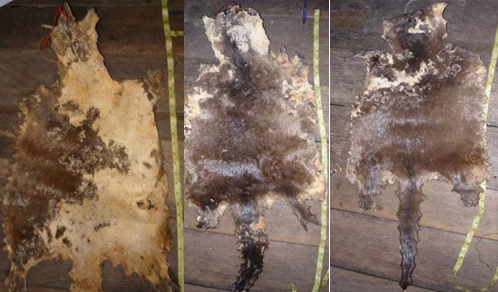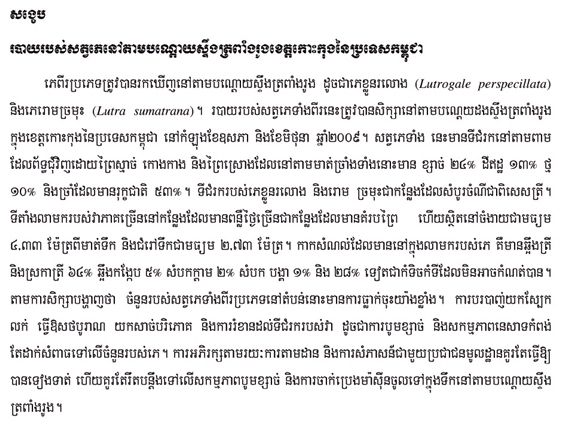IUCN/SSC Otter Specialist Group Bulletin

|
IUCN/SCC Otter Specialist Group Bulletin Volume 27 Issue 2 Pages 59 - 122 (June 2010) Citation: Dong, T., Tep, M., Lim, S., Soun, S. and Chrin, T. (2010). Distribution of Otters in the Tropeang Roung, Koh Kong Province, Cambodia. IUCN Otter Spec. Group Bull. 27 (2): 63 - 77 Distribution of Otters in the Tropeang Roung, Koh Kong Province, Cambodia Tangkor Dong1, Monorum Tep2, Sotheary Lim3, Sophall Soun4 and Tevy Chrin 5 1Tonle Sap Program Associate, Conservation International, Phnom Penh, Cambodia. Email: t.dong@conservation.org or tangkor_85@yahoo.com |
     |
|
Abstract: Two species of otters are found along Tropeang Roung River, the smooth-coated otter (Lutrogale perspecillata) and the hairy-nosed otter (Lutra sumatrana). The distribution of these species was studied along a stretch of the Tropeang Roung River in Koh Kong province, Cambodia, between May and June 2009. Their main habitat appears to be both small and big estuary surrounded by Melaleuca, Mangrove and evergreen forest with shoreline vegetation followed by sand (24%), clay (13%), rocky (10%) and bank with vegetation (53%), where is rich of food sources, particularly fish. The sprainting sites were found more under open sky then canopy cover, and situated their spraint in average of 4.33 m from water edge and 2.73 m of water depth. Diet compositions in spraint consisted of fish 64%, frog 5%, crab 2%, shrimp 1% and unidentified debris 28%. The study revealed that the distribution of otters along the river has diminished. Hunting for skin to trade, traditional medicine, meat and habitat disturbance such as sand mining and fishing activities might be putting pressure on the population. Conservation measures such as monitoring of the otter population and interviewing locals should be done regularly and restrictions on sand mining, oil spills from shipping and snaring should be imposed along Tropeang Roung River. |
| Keywords: Lutrogale perspecillata, Lutra sumatrana, habitats, threats, ecology |
| Française | Español | Khmer |
INTRODUCTION
The occurrences of four species of otter have been mapped by both Lekagul and McNeely (1977) and Corbet and Hill (1992) in Cambodia (Poole, 2003): Hairy-nosed otter (Lutra sumatrana), Eurasian otter (Lutra lutra), Smooth-coated otter (Lutrogale perspicillata) and Asian small-clawed otter (Aonyx cinerea). The smooth-coated otter is considered to be Vulnerable due to an inferred future population decline caused by habitat loss and exploitation (Hussain et al.,2008a), the hairy-nosed otteris considered to be Endangered due to past population declines. Based on estimated rates of decline, this species is suspected to have declined by up to 50% in the past 3 generations (30 years) due to illegal poaching and hunting, pollution, by catches and prey depletion due to over-fishing. The current rates of decline are expected to continue and further threaten this species. In its entire range, the hairy nosed otter is under increasing pressure due to high levels of poaching (Hussain et al.,2008b), the Asian small-clawed otter is considered vulnerable due to a projected future population decline due to habitat loss and exploitation. In the last few decades, the range of Asian small-clawed otter has shrunk particularly in its western portion, as evident from the published literature, (Hussain and de Silva,2008) and the Eurasian otter is considered to be near threatened due to an ongoing population decline but at a rate no longer exceeding 30% over the past 3 generations. There is concern about what is happening in parts of its range in Asia due to increasing habitat loss and poaching (Ruiz-Olmo et al.,2008).
Based on Poole's (2003) records, there were two species of otters with definite location records from Cambodia, the smooth-coated otter and the hairy-nosed otter. However, recent information show that three species of otters are now confirmed to exist in Cambodia: the smooth-coated otters found in most parts of Cambodia (Hon, 2008), the hairy-nosed otters found at Tonle Sap Great Lake (Olsson et al., 2007) and the small-clawed otters recently found in northeastern Cambodia (Hon et al., 2009).
The hairy-nosed otter is a medium-sized otter, around 1.3m in length and weighing around 7-8kg. The paws are fully webbed with well-developed claws. The fur is dark brown above, slightly paler underneath with a contrasting pale chin and upper lip. The whole nasal area (rhinarium) is covered in short, dark fur (Wright et al 2008). The hairy-nosed otter has limited distribution range. In Thailand, they are found in the Toa Daeng peat swamp forests, and also near the mouth of the Bang Nara River, which is low lying and tidal. In Viet Nam, the species have been reported from low lying peat swamp forests dominated by Melaleuca cajuputi in lower Mekong. In Cambodia, the species mainly live around the Tonle Sap Lake where the otters live mainly in the flooded forest and scrub surrounding the lake. Like many predators the hairy-nosed otter occurs in low density and the number and frequency of sightings are very few. In recent years, the tropical peat swamp forests have been under severe threat due to fire and other anthropogenic activities such as plantations for oil palm, production of food crops such as rice, corn and soyabean, and fish farming. In Viet Nam, the entire Mekong Delta has been converted into rice fields, reducing the habitat of otters and other wildlife species to a few parks. In Malaysia, fire reduced 70% of the Binsulok Forest Reserve and 10% of the Klias Forest Reserve. This has affected the surrounding environment and its biodiversity. In Indonesia, over the last 20 years, the ecosystem has been reduced from almost 30 million hectares to only about 15 million hectares, and most of what remains has already been logged selectively. Such levels of habitat modification have profound effects on the native biodiversity. All over its range, the hairy-nosed otter is under increasing pressure due to intensive poaching. In Cambodia, around the Tonle Sap Lake, poaching of otters and other wildlife is common practice. In Viet Nam otters are hunted for illegal wildlife trade, as well as for meat and medical use. These problems also occur in other countries of its range (Hussain et al.,2008b).
The smooth-coated otter is a large (7–11 kg) otter characterized by a very smooth, sleek pelage. Color varies from dark to reddish brown, with the undersides slightly lighter. The subspecies L. p. maxwelli is the darkest, with a dark brown to almost black coat. The belly is noticeably paler (Kanchansaka, 1988). The upper lip, cheeks, sides of neck, and throat are whitish or gray. The tail is flattened dorsoventrally, with a distinct lateral keel distally. The eyes and ears are small. The limbs are short, strong, with broad feet. All feet are fully webbed (Yeen and Serge 2005). This species is considered to be vulnerable due to a projected future population decline as a response to habitat loss and exploitation. The smooth-coated otter is essentially an otter of lowlands and floodplains. Major threats to the population are loss of wetland habitats due to construction of large-scale hydroelectric projects, reclamation of wetlands for settlements and agriculture, reductions in prey biomass as well as, poaching and contamination of waterways by pesticides (Hussain et al.,2008a).
The small-clawed otter is the smallest otter in the world (1-3 kg). The male is bigger than the female. The coat color is grayish brown. The color on the belly is lighter than on the sides of the body and on the back. However, the coat color changes from season to season. There is a periosteum between part of the toes, as such, their toes are free for movement, which is different from the other three species of the region. The nails are very short in adults. The juvenile small-clawed otters have long and curved nails, but they fall off when they become 5 weeks old. The small-clawed otters have tactile sensitivity on the front legs, this helps them to hunt efficiently, even in murky water, which is different from the big otters who use eyesight in hunting (Kanchansaka et al.,1998)
The Tropeang Roung River is situated in Peam Krasoap Wildlife Santuary, Koh Kong province. The presence of otters has been confirmed there (Hon and Dong, 2008), which makes it a significant area for research and conservation. There is very little data about the otter species along the Tropeang Roung, and the actual otter species present has not yet been clearly established. Because of this, we conducted this study in the area around Roung, focusing on otter distribution, otter species identification, habitats selection by otters and human impact on otters.
Survey Area
The study was carried out between May and June, 2009 on part of the coastal area in Koh Kong province. Six villages were chosen for conducting interview: Koh Sralau, Koh Andeth (Prek Popel and Koh Smach), Koh Kong Khnong, Prek Angkugn, Dei Tomneab and Tropeang Roung (Veal Tapou). Transect surveys were conducted river (Figure 1), situated in Peam Krasaob Wildlife Sanctuary between latitudes 11o20’ and 11o30’N and longitudes 103o03’ and 103o20’E. The vegetation at the survey sites are mangrove forests, melaleuca forests and evergreen disturbed forests. The beauty of the natural landscapes and wildlife at Peam Krasaob Wildlife Sanctuary is very important for eco-tourism and conservation. Many estuaries and vegetation along the watercourses are in an optimal state in terms of biodiversity. The vertebrate fauna is rich in fish, reptiles such as turtle species, snake species, and water monitor (Varanus niloticus), birds and mammals as Long-tailed Macaque (Macaca fascicularis), civet species, Hog badger (Arctonyx collaris), Rat species, Northern Slow Loris (Nycticebus bengalensis), Wild pig (Sus scrofa) etc).
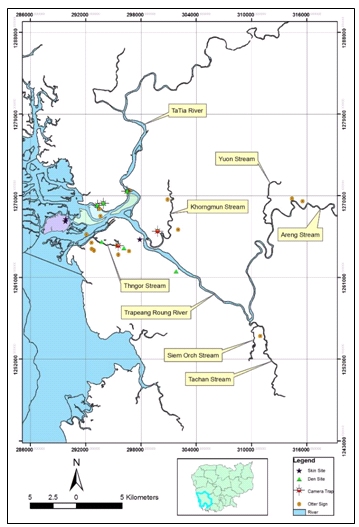 |
| Figure 1. Study sites along Tropeang Roung area. (click for larger version) |
METHODS
Interviews
Interviews were conducted with 50 local people who live around the survey sites. As the first step, local authorities were selected for interviewing in order to identify target groups, especially the chiefs of the villages. The interviewees were selected based on their experience; they might be fishermen, hunters, wildlife middlemen, or people who spend much time in the forest or in fishing activities. Those people were interviewed by using pre-designed semi-structured questionnaires in order to get information related to the distribution and abundance of otters, their presence both in the present and in the past, their biological characteristics, threats to otters caused by human activities and other factors, wildlife trade in otters or their parts, and general awareness of the value and importance of otters.
Transect Lines
Transect surveys were done for direct observation of otters and their sign . Transects were designed to cover all habitat types and followed waterways such as canals, streams and swamps (Nguyen et al, 2001). Sixteen transect lines were done along the waterways. The length of transect surveys was not fixed; it was based on the situation of canals, streams and swamps. Most transect surveys were carried out by boat because of dense forest along waterways. Where travelling by boat was impossible, transect survey had to be conducted on foot. Where otter signs were found, habitat assessments were also done. Signs could be spraint sites, grooming sites and dens (Anoop and Hussain, 2004). Only smooth areas were measured as rolling site and dens were measured up to down and around hole.
Spraint Collection
Spraints were collected for analysis of otter prey categories. One to four samples of spraint were collected at each spraint site (depending on the number of different spraints at that site). All spraints which were collected were washed under tap water in a steel sieve of mesh size 1 mm (Anoop and Hussain, 2004) and then dried.
Habitat Assessment
Plots were laid around wherever otter signs were found (Anoop and Hussain, 2004). We intended to use plot sizes of 5x10m for habitat assessment; but due to weather conditions (flooding), the situation of the survey sites and the abundant tree species in these study area, the actual plot sizes used were 25m2 (5x5m). The habitat variables measured were: distance from water edge to sign, water depth, river width, number of spraint sites, and number of basking and grooming sites (Anoop and Hussain, 2004). Habitat was also classified according to the percentage of canopy cover, ground cover and vegetation. Canopy cover was assessed using a simple method that uses a hole in a piece of paper or large leaf to judge proportions of canopy and open sky. For ground cover, we assessed the proportions of leaf litter, grass cover, soil, rock and sand in the plot area. The vegetation types were measured focusing on vegetation diameter and height. Observed disturbance and threats to otters were also recorded during the survey period.
Camera Trapping
Camera traps were set during the survey in order to identify otter species and threats from humans. Two types of camera traps were used (Cam Trakker, Reconyx 1.3 mpx Mono R). The camera-traps were set at 24 hour activity. The Reconyx 1.3 mpx Mono R powered by six alkaline batteries [batteries (CC)], was set to automatically take batches of three successive pictures when triggered, and the Cam Trakker, powered by eight alkaline batteries [4 batteries (CC) and 4 batteries (AA)], was set to take one picture at a time, with a 10 second delay after triggering. The traps were set for periods of one month at 5 locations in the study area. They were set up in front of otter spraint sites, grooming sites and otter dens. The camera trap setting was flexible base on the location of the signs; they were set in the distance about 1.5 to 2 meters away from otter sign.
RESULTS
Interviews
The 50 interviewees were interviewed in villages along the survey sites. Most of them work closely with natural resources because their livelihoods still depend on them. Three main occupations of interviewees were detected (Figure 2): fishermen, farmers and middlemen. For local people who are fishermen and farmers, they always have a second job to support their family such as going into forests to collect non-timber forest products or to fish etc.
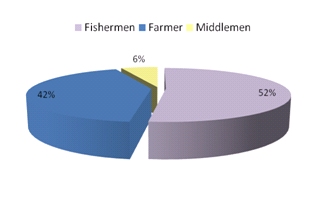 |
| Figure 2. The main occupations of interviewees in the study area |
Distribution and species of otter
The interviewees’ responses showed that all of them (100 %) used to see otters (Table 1). Nevertheless, the local people could not identify otter species, they just identified them by color as “black” (dark brown) and “grey” (paler brown). The black otters are actually L. sumatrana and the grey otters are L. perspicillata.
The local people considered that recently, the otter population has declined rapidly because the present of otters have been less than in the past since sand mining were invested in their areas.
The local people also noticed that otters have always been present along watercourses such as Koh Smach, Koh Krey, Prek Popel, Prek Thngor, Prek Tachan, Prek Khorngmun etc (Koh means Island, Prek: means stream or river). They often saw otters swimming, and walking near the water’s edge at low tide. 87.5 % of interviewees saw otters rolling on sand and 12.5 % on grass. Sometimes, they saw otters were catching food along streams. Local people confirmed that otters were present both during day time and at night, and that they caught fish, crabs and shrimp at low tide when they are easy to catch.
Threats
Habitat loss and disturbance: By observation and through the interviews we found that the river banks where otters used to be seen have been destroyed by commercial sand mining. 80 % of local people stated that sand mining only impacted otter habitats, but their own settlements are also facing this issue as well. Food and other economic resources for local livelihoods are being affected because fish, crabs and shrimp yields are now in decline. Sand mining operates both day and night, and has transformed the ecosystem of aquatic animals. In addition, water pollution is caused by fuel leaks from their ships, which has had a great effect on the degree of biodiversity in the area. The sound from the machines also disturbs wildlife, including otters. In addition, forests around the streams are cut down for trade (Melaleuca trees) and making energy (charcoal production).
Hunting and otter trade: Otters are not the main hunting targets for local people, but hunting per say still pose a serious threat to otters. The most common situation when otters are killed is when they come close to settlements and raid fishing equipment. Sometimes, local people go out to hunt other wildlife, but when they meet otters, they will kill them for food, traditional medicine and skins for trade. During interviews, only 32 % of respondents said they had caught otters. Methods include using fishing equipment, guns, dogs, and directly by hand (Figure 3). Local people also said that sometimes otters were killed by accident, especially when raiding fishing gear.
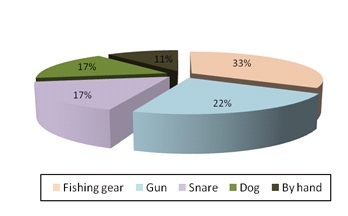 |
| Figure 3. Methods used by local people for catching otters in the study area |
Otters and other parts are currently being illegally traded in the survey areas. The middlemen in the local areas buy wildlife and wildlife products from local people and sell them outside the area, such as in Koh Kong town. The prices reflect the type of body part and its quality (Table 2).
The high prices and traditional beliefs of local people have contributed to the decline of the population of otters. Five otter skins were found in Koh Sralau village, Koh Kapi commune and parts of otters were found at a wildlife middleman’s house in Koh Kong Khnong village, Tropeang Roung commune during the interviewing and observations. Three of the otter skins are blackish in color, being those of the hairy-nosed otter (Figure 4) and two skins and other body parts (otter feet and penises) are grey in color, from smooth-coated otters (Figure 5).
Transect Survey
Fifty signs total of otters were found during the transect survey: 19 spraint sites, 25 grooming sites and six dens.
Sprainting sites
Spraint color depends on how long they have been deposited and in what habitat. Otters defecated on leaf litter, soil, rock and sand. The survey was done in the rainy season, and rain affected the size and the shape of spraints, so we could not measure and identify whether they were fresh or old (Figure 6).
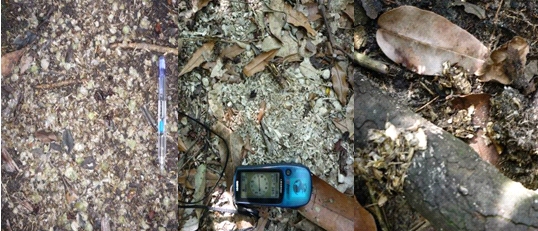 |
| Figure 6. Otter spraint found at a survey site during a transect survey |
From spraint analyses, the most abundant prey remains were fish bones and scales, followed by crabs, shrimps and unidentifiable remains (Figure 7)
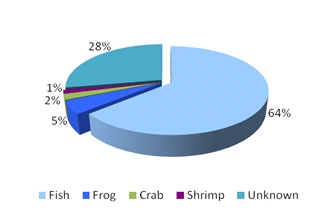 |
| Figure 7. Percentage of otters’ prey found in 19 scats in the Tropeang Roung Areas |
Rolling sites
Rolling sites were used by otters for rolling and basking. All rolling sites were found associated with spraint sites within an average distance of 2m. 56% of rolling sites were on soil, 40% on sand and 4% on rock. On average, each spraint site was associated with 2 rolling sites.
Dens
Of the six dens found along streams, two where in natural rock crevices, three were dug into the substrate close to the shoreline and one was dug under the roots of a tree. The average distance of dens from the water’s edge was 2.83 m (standard error = 0.74, range distance: 1-6 m) and the average distance from spraint and rolling sites was 20.5 m (standard error = 7.17, range distance: 2-50 m). According to the local guides, those dens have been used by otters when they got pregnant and looked after young cubs because the guides used to see otters with their small cubs. Some of the local guides used to catch otter cubs from those dens.
Habitat type
The typical (average) habitats selected by otters had slow water currents, an average water depth of 2.73 m (standard error = 0.32), and a river width of approximately 75 m (standard error = 35.01). Otter signs were found an average of 4.33 m (standard error = 1.36) from the water’s edge. Vegetation tended to be around 4 m in height, with an average trunk diameter of 0.096 m (standard error = 0.34). The watercourse banks were of various compositions (Table 3).
|
|
|
| Table 3: Bank characteristic of streams at 50 sites used by otters in the survey area | |
|
|
|
| Habitat type | Bank Characteristic (%) |
| Sand bank | 24 |
| Rocky bank | 10 |
| Clay bank | 13 |
| Bank with vegetation | 53 |
|
|
|
Thirty-four tree species were recorded at otter sign sites. The dominant vegetation in habitats which were selected was shown in Table 4.
Areas chosen by otters (sites found with signs during survey) were characterized by canopy cover and open sky. According to analysis showed that 61% of otter sign sites were under open skies, and 39% under canopy cover. The ground cover was mainly leaf litter and soil (Figure 8).
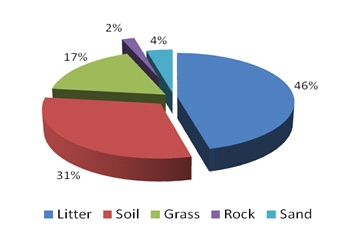 |
| Figure 8. Ground cover components in spraint and rolling sites |
Camera Trapping
Eight wildlife species were recorded during camera trapping. Those species were:
- Mammal: Common Palm Civet (Paradoxurus hermaphroditus) , fishing cat (Prionailurus viverrinus), long-tailed macaque (Macaca fascicularis), rat species, Berdmore’s squirrel (Menetes berdmorei), squirrel species, hog badger (Arctonyx collaris), East Asian porcupines (Hystrix brachura)
- Bird: bird species
There were 6 pictures of civet species, 3 pictures of fishing cat, 36 pictures of long-tailed macaque, 31 pictures of rat species, 39 pictures of quarrel species, 55 pictures of hog badger, 8 pictures of East Asian porcupines, 3 pictures of bird species and 1 picture of an unknown species were recorded by cameras. No otters were recorded during camera trapping.
DISCUSSION
The present of two species of otters were confirmed in the study areas, the smooth-coated and hairy-nosed otters. The presence of smooth-coated otters was confirmed at Tatai Krom (Heng and Hon, 2007) and the hairy-nosed otter was confirmed to be present at Koh Kong Khnong in 2008 (Hon and Dong, 2008). During our study, it was the wet season and waterways were flooded during the survey period, so it was impossible to walk transects along all the waterway’s banks. On the other hand, much evidence indicated that the two species of otter are present in our survey area. Three skins of hairy-nosed otters were present in a wildlife middleman’s possession, dark in colour, and with the rhinarium covered in hair (Kanchanasaka, 1998 and Wright et al., 2008).Two smooth-coated otter skins were also found in the local people’s houses (identified by its paler coat, especially on the belly). There is very little data available from the literature to compare past and present populations of smooth-coated and hairy-nosed otters in the study area, but after interviews with local people in six villages in the study area where the existence of otter was confirmed during the survey, the overall opinion expressed was that the otter population is facing a decline.
The main contributing factors to this pressure on the otter population is the economic poverty of local people, unemployment and lack of awareness about otters and the activities which generally degrade the environment for both humans and wildlife, sand mining, fuel leakage, deforestation and charcoal production. High demand for otter skins in China and Tibet (IOSF, 2008) and its high price (Khan et al, 2008) in the study area, coupled with the low risks for the hunters because of the weakness of wildlife law enforcement, creates a strong encouragement for local people to hunt otters. Along Tropeang Roung River, there is a lot of sand mining, which has eroded some areas close to the river, adversely affecting the ecosystem and hence reducing the abundance of otter prey such as fish, shrimps and crabs, and also staple foods of local people (Sebastian and Vong, 2009). According to the interviewees, the fish and crab yields have decreased rapidly. The combination of competition for food, and the high price of skins have caused a small group of fishermen to make snares and traps to catch otters and sell them to traders. Local people also believe that the skin and penis of an otter are important in traditional Cambodian medicine, which apparently uses the skin in wine to assist women during pregnancy and/or childbirth (Poole, 2003). According the people along Tropeang Roung River, the otter were used for Cambodian traditional medicine too. The dried penis are rubbed with the rock and mixed with coconut milk as the sexual medicine. It helps the people to increase the sexuality
Apart from this, evidence of deforestation and charcoal were recorded, resulting in destruction of vegetation in areas used by otters, as well as disturbance by noise, dogs, etc. Otters may be most vulnerable to disturbance when they are raising cubs (Hussain and Choudhury, 1997)
The most likely reason that the camera traps did not capture any otter pictures. Probably, because of disturbance from human activities, otters were not back to their sites. Lopping of trees, setting of fishing nets and settlements occurred near trap sites. Additionally, sand companies were active night and day, and were traveling along the streams. This probably affected the chance of otter going to trap sites. These causes were obstacles for camera trapping. Human occupancy of natural wetlands has created a difficult situation for otters that rely on this habitat for food (Khan et al, 2009). Furthermore, the study period was in the rainy season, which affected trap locations. Two camera traps (Cam Trakkers) were destroyed by rain during the survey, and only three camera traps recorded any wildlife.
CONCLUSIONS
From the considerable decrease in the number of positive sites and sightings of otters and the small number of spraint sites found, we conclude that the population of otters along the Tropeang Roung River is in decline. The Tropeang Roung area is currently controlled by the Wildlife Alliance cooperating with Forestry Administration to try to ensure that most of the wild animals are well protected. Otters have been thus receiving protection along with other aquatic fauna. However, there is no distinct management policy for otter conservation and it is suggested that conservation programs and monitoring activities be extended by the management staff of the authority and other partner organizations to determine future trends in the otter population along the Tropeang Roung River, and determine and implement mitigation measures in order to especially protect the globally rare hairy-nosed otter. Sand mining needs to be controlled, and snaring, charcoal production, cutting and lopping of trees along the banks should be strictly prohibited.
Acknowledgements - We would like to thank Conservation International, Cambodia for providing opportunities for Cambodian students to study otter species, and the International Otter Survival Fund (IOSF) who provided funding for this study. We would like to express our gratitude to the Mr. Seng Bunra, Annette Olsson, Dr. Nicole Duplaix, Carol Benetto, Lesley Wright, Arno Christian, Mr. Pov Somanak, Mr. Heng Sokrith, Mr. Chey Koulang, Clarisse Reiter, Hon Naven, Kheng Sokhorn and Mr. Chantha for guidance. Furthermore, we also express our sincere gratitude to Royal University of Phnom Penh, Prek Leap National School of Agriculture, Department of Environment and Forestry Administration and local authorities in Koh Kong province for granting us the permission to study in the area.
REFERENCES
Anoop K.R., Hussain S.A. (2004). Factors affecting habitat selection by smooth-coated otters (Lutra perspicillata) in Kerala, India. J. Zool. 263: 417–423.
Corbet, G. B. and Hill, J. E. (1992). Mammals of the Indomalayan region: a systematic review. Natural History Museum Publications and Oxford University Press, London and Oxford.
Heng S., Hon N. (2007). Survey in Tatai Krom Commune, Koh Kong Province. Unpublished Report for Conservation International-Cambodia.
Hon N., Dong T. (2008). Otter Reseach at Peam Krosoup Wildlife Sanctuary, Koh Kong province. Unpublished Report for Conservation International-Cambodia.
Hon N., Neak P., Khov V. ND Cheat V. (2009). Food and habitat of Asian small-clawed otter in Northeastern Cambodia. IUCN Otter Spec. Group Bull. 27 (1): 12-23.
Hussain, S. A., Choudhury, B.C. (1997). Distribution and status of the smooth-coated otter Lutra perspicillata in National Chambal Sanctuary, India. Biological Conservation, 80: 199-206.
Hussain, S.A., de Silva, P.K. 2008. Aonyx cinerea. In: IUCN 2009. IUCN Red List of Threatened Species. Version 2009.1.
[http://www.iucnredlist.org/. Downloaded on 05 October 2009.]
Hussain, S.A., de Silva, P.K., Mostafa Feeroz, M. (2008a). Lutrogale perspicillata. In: IUCN 2009. IUCN Red List of Threatened Species. Version 2009.1.
[www.iucnredlist.org. Downloaded on 30 June 2009]
Hussain, S.A., Kanchanasakha, B., de Silva, P.K., Olsson, A. (2008b). Lutra sumatrana. In: IUCN 2009. IUCN Red List of Threatened Species. Version 2009.1. <www.iucnredlist.org>. Downloaded on 08 July 2009.
IOSF. (2008). Alarming Trade in Otter Fur. IOSF. 7 Black Park, Bradford, Isle of Skye, IV49 9DE, Scotland. 11 pp
Kanchanasaka, B., Simcharoen, S., Than, U.T. (1998). Otter: Oriental small-clawed otter. Carnivores of Mainland South East Asia. pp 73-86
Khan, W. A., Qasim, M., Ahmad, E., Akbar, G., Habib, A. H., Ali, H., Mueen, F., Chaudhry, A. A., Iqbal, S. Bhaagat, H. B., Akhtar, M., Ahmad, M. S. (2009). A survey of smooth-coated otters (Lutrogale perspicillata indica) in the Sindh Province of Pakistan. IUCN Otter Spec. Group Bull. 26(1), 15-32.
Khan, W. A., Qasim, M., Ahmad, E., Bhagat, H.B. (2008). Literature review on biology and ecology of Smooth coated otter (Lutrogale perspicillata). Internal Report, WWF Pakistan, Ferozepur Road, Lahore. 13 pp.
Lekagul, B., Mcneely, J.A. (1977). Mammals of Thailand.Association for the Conservation of Wildlife (as updated 1988). Bangkok.
Nguyen X. D., Pham T. A., Le H.T. (2001).New information about the hairy-nosed otter (Lutra sumatrana) in Vietnam. IUCN Otter Spec. Group. Bull. 18(2): 64-75.
Olsson, A., Heng, S., Hon, N., Peov, S., Nop, N. (2007). Cambodia Otter Research and Conservation Project. Presentation at Xth International Otter Colloquium, October 10-16th, 2007, Hwacheon, South Korea.
Poole, C.M. (2003). The first records of hairy-nosed otter Lutra sumatrana from Cambodia with notes on the national status of three other otter species. Nat. Hist. Bull. Siam Soc.51(2): 273-280.
Ruiz-Olmo, J., Loy, A., Cianfrani, C., Yoxon, P., Yoxon, G., de Silva, P.K., Roos, A., Bisther, M., Hajkova, P., Zemanova, B. 2008. Lutra lutra. In: IUCN 2009. IUCN Red List of Threatened Species. Version 2009.1.
[
<http://www.iucnredlist.org/>. Downloaded on 05 October 2009.]
Sebastian, S., Vong, S. (2009). Spike in Cambodia sand mining “appears to coincide with the end of sand exports from Indonesia to Singapore”. Sand mining spikes in Koh Kong estuaries. The Phnom Penh Post 10 Mar 09.
[
<
http://wildsingaporenews.blogspot.com/2009/03/ spike-in-cambodia-sand-mining-appears.html>. Access on 3 Mar 2010.]
Sivasothi, N., Burhanuddin, Hj. Md. Nor. (1994). A review of otters (Carnivora: Mustelidae: Lutrinae) in Malaysia and Singapore. Hydrobiologia 285: 151-170.
Wright, L., Olsson, A., Kanchanasaka, B. (2008). A working review of the hairy-nosed otter (Lutra sumatrana) IUCN Otter Spec. Group Bull. 25(1), 38-59.
Yeen, T. H., Serge, L. (2005). Lutrogale perspicillata. Mammalian Species, 786: 1 - 4.
Résumé : La Distribution des Loutres sur la Region de Tropeang Roung Dans la Province de Koh Kong au Cambodge.
Dans certaines régions, la loutre eurasienne (Lutra lutra) est connue pour avoir une période de reproduction saisonnière. Cependant, en Angleterre et au Pays de Galles, la période de reproduction semble s’étendre sur toute l’année. Dans cette étude, nous testons cette hypothèse en utilisant des données provenant de 206 femelles trouvées mortes en Angleterre et au Pays de Galles entre 1992 et 2008. Des femelles pleines ont été trouvées tout au long de l’année à l’exception du mois de juin. Les données ne montrent pas de reproduction saisonnière. Le nombre moyen d’implantations embryonnaires (basé sur les cicatrices placentaires) était de 2.36. Les données sur le développement fœtal de la loutre sont limitées. Des fœtus prélevés dans l'utérus sont utilisés ici pour décrire le développement fœtal, ce qui limite nos données d’observations - nous souhaitons donc lancer un appel aux autres chercheurs afin d’obtenir davantage d’informations.
Revenez au dessus
Resumen: Distribución de Nutrias in la Region de Tropeang Roung, Provincia de Koh Kong en Cambodia
En algunas partes de su distribución, la nutria euroasiática (Lutra lutra) presenta una reproducción estacional, pero en Inglaterra y Gales se cree que su reproducción ocurre a lo largo de todo el año. En este estudio evaluamos esta suposición utilizando los datos de 206 hembras halladas muertas en Inglaterra y Gales entre 1992 y 2008. Se encontraron hembras preñadas en todos los meses excepto en el mes de junio, sin encontrar ninguna evidencia de estacionalidad. La media de implantaciones embrionarias, basado en las cicatrices de la placenta, fue de 2,36. La información sobre el desarrollo fetal de nutrias es limitada; nosotros utilizamos fetos de nutrias encontrados en los úteros para describir el desarrollo y hacer un llamamiento a la información de otros investigadores.
Vuelva a la tapa
